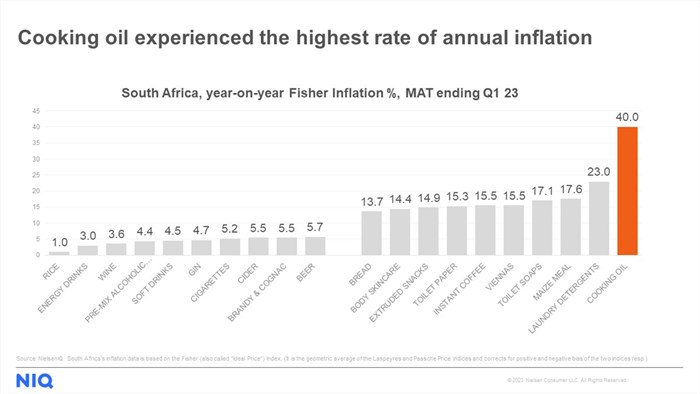The report highlights a more comprehensive understanding of food inflation and unveils intriguing developments, showing that the sector's annual sales have reached R593bn by the end of March 2023, marking a substantial 13.4% growth compared to the previous year.
NIQ South Africa consumer panel commercial lead Steve Randall stresses however that; “It’s important to understand that the overall growth we calculate is the combined increase in value (rand sales) and volume (units sold). The stark reality is that this ‘real’ growth is primarily being driven through price increases and not organic consumption growth.
Inflation nation - A fresh take
Randall also points out that CPI is often overrepresented and sometimes misunderstood when conducting a robust analysis of the real impact of food price increases.
“Overall CPI is currently sitting at 6.3% (down from 6.8% in the previous month) and as a result, people say it is cooling but food inflation is still sitting much higher at 12.2% and has only started to normalise in April/May of this year.
The Stats SA food inflation figure has wide recognition in the market and is a useful measure but it can only realistically look at a subset of items and observed prices at a point in time.”
NIQ uses barcode level information across the widest coverage of the market gathered from its vast retail measurement (scanned barcode data at 10,000 modern trade stores, coupled with a statistically representative panel of traditional trade stores) which covers 100,000 FMCG products.
This provides NIQ with the richest possible dataset from which robust analysis can be conducted on. Randall explains; “We use item-level data to calculate inflation and consider items that have sales last year and this year. Due to our granularity, we use a naturally weighted basket (not a statistically estimated basket), which results in a more accurate view.”
A thorough analysis
Using this focused approach, NIQ has conducted a thorough analysis of the inflation pressure areas within FMCG during the last 12 months.
Unsurprisingly, cooking oil experienced the highest rate of annual inflation (into Q1’23) having experienced a 40% increase and remains the biggest contributor towards overall net FMCG inflation, contributing 7.2% “share” of inflation even though it accounts for less than 2% of total sales.
Interestingly, the full effect of these massive cooking oil price increases has created a change in consumer consumption patterns around this product. In response to the price increases, volumes purchased have dropped steadily over the last three quarters, an indication that despite its essential nature, consumers are curtailing their usage of this product.
Tannur Anders and Anait Miridzhanian 5 Jul 2023 Cooking oil’s steep prices have also had knock-on effects across the consumption chain given that it’s also a complementary product to frozen chicken - the price of which has also risen. This means the cost of what could have been considered a staple meal - namely chicken cooked in oil - has drastically increased.
However, looking forward Randall qualifies that there has been a steadying of the price of cooking oil over the last three months and that the NIQ team expects inflation to ease in this product category and more broadly across the range of Top 40 products it measures.
Interesting alternatives
That said, consumers will continue to strategise in the short term, and might well look towards alternatives like pork which is now comparably priced to frozen chicken or tinned protein which offers a longer, more cost-effective shelf life versus frozen protein. In addition, rice might also be considered a better alternative to maize meal, which has experienced a 17.6% annual increase versus the inflation for rice which is at 1.0%.
Randall adds that it’s important to note that increased promotional intensity, coupled with increased promo seeking from consumers, does bring down the level of inflation in a particular category. This is evident in a category like rice while a category such as coffee has seen high inflation (15.5%) due to decreased promotion and higher everyday prices.
A time to innovate
Looking ahead Randall feels resilience can be built into manufacturer and retailer strategies despite the uncertainty around load shedding and the spectre of continued increases in the price of diesel.
“We continue to advise our clients on key ways to combat current consumer constraints by asking how their products can be offered as solutions to on the ground problems like price increases and meeting this need with innovative but responsible pricing strategies. In addition, digging deeper into Traditional Trade (Independent) retail channels that are yielding better volumes than many modern trade outlets at present, is also recommended as a key option to consider.”




































